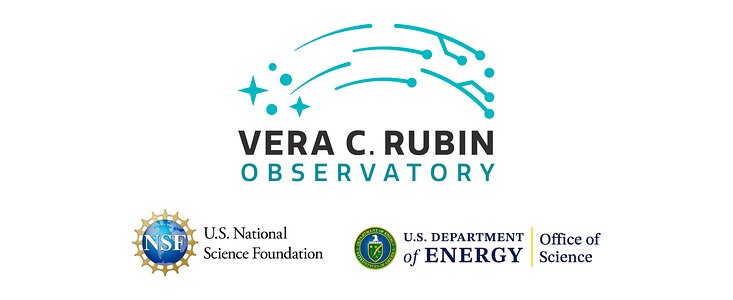Rubin Observatory Unveils its Logo
3 December 2020
Vera C. Rubin Observatory is pleased to announce the release of its official logo following the organization’s renaming in December 2019. Formerly known as the Large Synoptic Survey Telescope, Rubin Observatory was renamed, by an Act of Congress, to honor American astronomer Vera C. Rubin, a pioneer in the study of dark matter and an advocate for women in science.
The logo is a visual representation of Rubin Observatory’s central purpose: to collect light from celestial objects and transform it into data for scientific discovery. It is aligned with Rubin Observatory’s mission for operations: to create a vast astronomical dataset and web-based analysis environment for unprecedented discovery of the deep and dynamic Universe.
The logo is made up of elements that reflect Rubin Observatory’s priorities and core values. The variety of celestial objects, each one a unique shape or size, symbolizes Rubin Observatory’s commitment to diversity. The curved lines invoke the transformation of light from these objects into data, which are represented as traces on electronic readout boards: line segments with dots. The arc of the lines suggests time-lapse photography, in which stars appear as curved streaks in the sky, because Rubin Observatory data from the Legacy Survey of Space and Time (LSST) will provide the first time-lapse view of the southern hemisphere sky. Finally, the foundational position of Vera C. Rubin’s name in the logo honors her legacy and reflects our pride at being the first major US national scientific facility to be named after a woman scientist. José Pinto, Graphic Designer at Rubin Observatory, led the development process and he comments, “We are very enthusiastic about the final design, but even more so about the collaborative, inclusive process that led to it.”
The logo was chosen by a committee of stakeholders from across the Rubin Observatory ecosystem; it included representation from the Association of Universities for Research in Astronomy (AURA), SLAC National Accelerator Laboratory and NSF’s NOIRLab operated by AURA. The process — from the initial proposed designs, to a thoughtful iterative phase, to the final selection — was guided by a detailed design brief which outlined a set of requirements for the logo. These requirements were determined by best practices in graphic design, and by the results from a survey that was widely distributed, within the Rubin community and to members of the public, earlier this year.
The logo is an important part of Rubin Observatory’s preparations for the start of science operations in 2023. Additional work includes a new, interactive website, which will provide the public with opportunities to explore Rubin Observatory data and to learn how those data contribute to science and discovery.
More information
Rubin Observatory, currently under construction on Cerro Pachón in Chile, will employ the 8.4-meter Simonyi Survey Telescope and the 3200-megapixel LSST Camera to capture about 1,000 images of the sky every night for ten years. Each image will cover a 9.6-square-degree field of view, or about 40 times the area of the full Moon. LSST survey images will contain data for about 20 billion galaxies and a similar number of stars — more celestial objects than there are humans on Earth. Rubin Observatory data will be used for scientific investigations ranging from cosmological studies of the Universe to searches for potentially dangerous Earth-impacting asteroids. Additionally a public engagement program will enable anyone to explore the Universe and be part of the discovery process.
This federal project is jointly funded by the National Science Foundation (NSF) and the Department of Energy (DOE) Office of Science, with early construction funding received through private donations through the LSST Corporation. The NSF-funded LSST Project Office for construction was established as an operating center under the management of the Association of Universities for Research in Astronomy (AURA). The DOE-funded effort to build the LSST camera is managed by the SLAC National Accelerator Laboratory (SLAC).
NSF and DOE will continue to support the Rubin Observatory in its Operations phase to carry out the Legacy Survey of Space and Time. They will also provide support for scientific research with the data. During operations NSF funding is managed by the Association of Universities for Research in Astronomy (AURA) under a cooperative agreement with NSF and DOE funding is managed by SLAC under contract by DOE. Rubin Observatory is operated by NSF’s NOIRLab with support from the NSF and the Department of Energy’s Office of Science.
NSF’s NOIRLab (National Optical-Infrared Astronomy Research Laboratory), the US center for ground-based optical-infrared astronomy, operates the international Gemini Observatory (a facility of NSF, NRC–Canada, ANID–Chile, MCTIC–Brazil, MINCyT–Argentina, and KASI–Republic of Korea), Kitt Peak National Observatory (KPNO), Cerro Tololo Inter-American Observatory (CTIO), the Community Science and Data Center (CSDC), and Vera C. Rubin Observatory. It is managed by the Association of Universities for Research in Astronomy (AURA) under a cooperative agreement with NSF and is headquartered in Tucson, Arizona. The astronomical community is honored to have the opportunity to conduct astronomical research on Iolkam Du’ag (Kitt Peak) in Arizona, on Maunakea in Hawaiʻi, and on Cerro Tololo and Cerro Pachón in Chile. We recognize and acknowledge the very significant cultural role and reverence that these sites have to the Tohono O'odham Nation, to the Native Hawaiian community, and to the local communities in Chile, respectively.
Links
- Rubin Observatory Logo
- Announcement on lsst.org
- Rubin Observatory Promotional Video
- Rubin Observatory website
Contacts
Ranpal Gill
Rubin Construction Head of Communications Office
+1 520 309 6195
Email: rgill@lsst.org
Amanda Kocz
Press and Internal Communications Officer
NSF’s NOIRLab
Cell: +1 626 524 5884
Email: amanda.kocz@noirlab.edu


